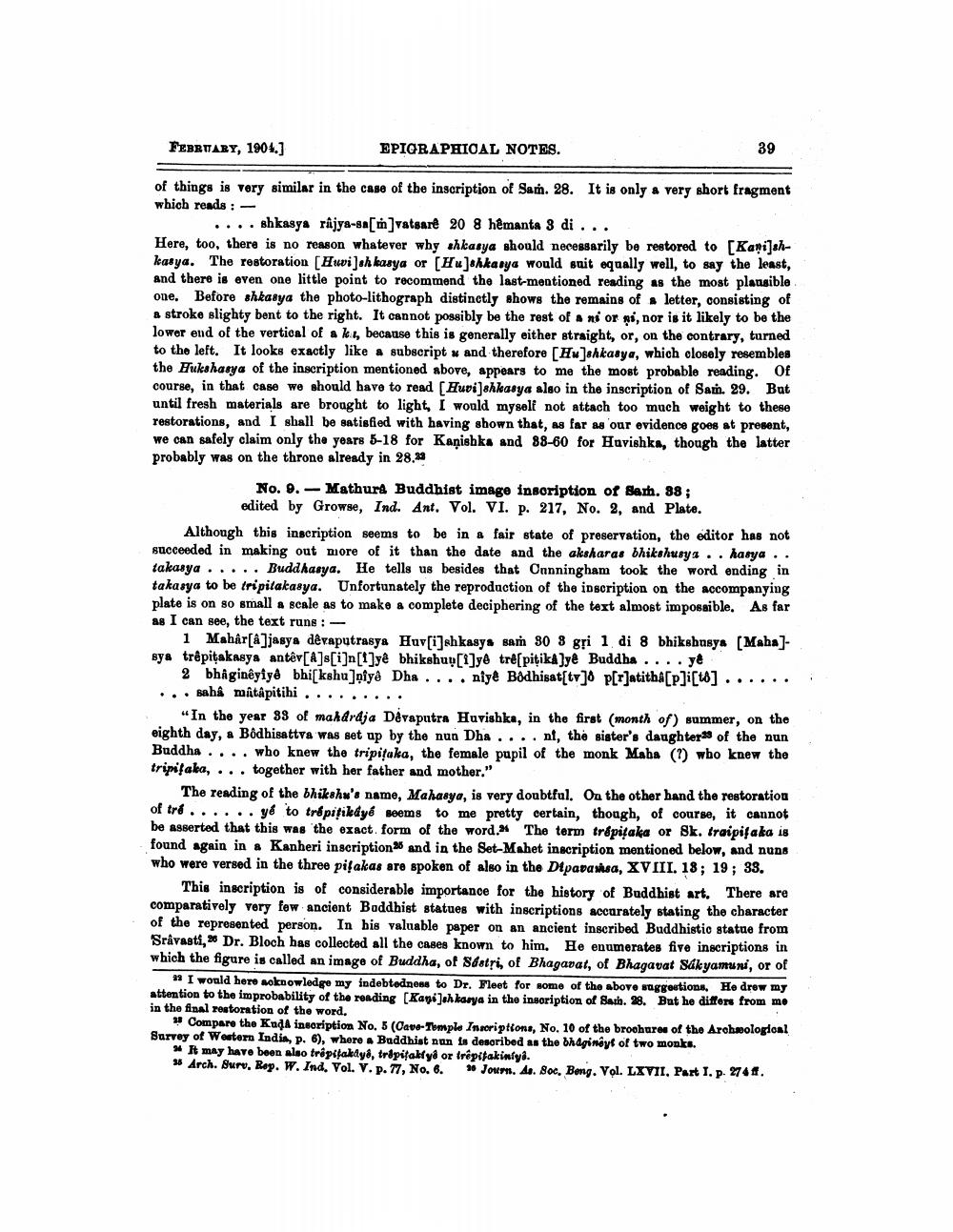________________
FEBRUARY, 1904.]
of things is very similar in the case of the inscription of Sam. 28. It is only a very short fragment which reads:
EPIGRAPHICAL NOTES.
39
..shkasya rajya-sa[m] vatsarê 20 8 hêmanta 3 di . . .
Here, too, there is no reason whatever why shkasya should necessarily be restored to [Kanishkasya. The restoration [Huvi]sh kasya or [Hu]shkasya would suit equally well, to say the least, and there is even one little point to recommend the last-mentioned reading as the most plausible. one. Before shkasya the photo-lithograph distinctly shows the remains of a letter, consisting of a stroke slighty bent to the right. It cannot possibly be the rest of a ni or ni, nor is it likely to be the lower end of the vertical of a kz, because this is generally either straight, or, on the contrary, turned to the left. It looks exactly like a subscript u and therefore [Hu]shkasya, which closely resembles the Hukshasya of the inscription mentioned above, appears to me the most probable reading. Of course, in that case we should have to read [Huvi]shkasya also in the inscription of Sam. 29. But until fresh materials are brought to light, I would myself not attach too much weight to these restorations, and I shall be satisfied with having shown that, as far as our evidence goes at present, we can safely claim only the years 5-18 for Kanishka and 88-60 for Huvishka, though the latter probably was on the throne already in 28.23
No. 9. Mathura Buddhist image inscription of Barh. 38; edited by Growse, Ind. Ant. Vol. VI. p. 217, No. 2, and Plate.
Although this inscription seems to be in a fair state of preservation, the editor has not succeeded in making out more of it than the date and the aksharas bhikshusya.. hasya.. takasya..... Buddhasya. He tells us besides that Cunningham took the word ending in takasya to be tripitakasya. Unfortunately the reproduction of the inscription on the accompanying plate is on so small a scale as to make a complete deciphering of the text almost impossible. As far as I can see, the text runs :
1 Mahar[a]jasya dêvaputrasya Huv[i]shkasya sam 30 8 gri 1 di 8 bhikshusya [Maha]sya trêpitakasya antêv[A]s[i]n[1]yê bhikshup[i]yê trê[pitika]yê Buddha.... yê
2 bhaginêyîyê bhi[kshu]nfyê Dha.... niyê Bodhisattv]o p[r]atithâ[p]i[to].... ... sahâ mâtâpitihi
"In the year 33 of mahdrdja Davaputra Huvishka, in the first (month of) summer, on the eighth day, a Bodhisattva was set up by the nun Dha.... nt, the sister's daughters of the nun Buddha.... who knew the tripitaka, the female pupil of the monk Maha (?) who knew the tripifaka,.. together with her father and mother."
The reading of the bhikshu's name, Mahasya, is very doubtful. On the other hand the restoration of tre...... ye to trépitikáyé seems to me pretty certain, though, of course, it cannot be asserted that this was the exact form of the word. The term trépitaka or Sk. traipifaka is found again in a Kanheri inscription and in the Set-Mahet inscription mentioned below, and nuns who were versed in the three pifakas are spoken of also in the Diparassa, XVIII. 18; 19; 33.
This inscription is of considerable importance for the history of Buddhist art. There are comparatively very few ancient Buddhist statues with inscriptions accurately stating the character of the represented person. In his valuable paper on an ancient inscribed Buddhistic statue from Srâvasti, Dr. Bloch has collected all the cases known to him. He enumerates five inscriptions in which the figure is called an image of Buddha, of Sastri, of Bhagavat, of Bhagavat Sakyamuni, or of
32 I would here acknowledge my indebtedness to Dr. Fleet for some of the above suggestions. He drew my attention to the improbability of the reading [Kanishkasya in the insoription of Sath. 28. But he differs from me in the final restoration of the word.
Compare the Kuda inscription No. 5 (Cave-Temple Inscriptions, No. 10 of the brochures of the Archaeological Survey of Western India, p. 6), where a Buddhist nun is described as the bhdginêyt of two monks.
24 It may have been also trêpitakiyê, tripitakiyê or trêpitakinlys.
35 Arch. Surv, Rep. W. Ind, Vol. V. p. 77, No. 6. 26 Journ. As. Soc, Beng. Vol. LXVII. Part I. p. 274ff.




